How to use darkmode everywhere
After many years of waiting, the dark mode has finally gone mainstream. Every developer out there is implementing dark mode as an essential feature and rightfully so. No matter if it's an operating system, an app, or a website, dark mode is everywhere. So in this article, I have gathered all the bits and pieces about dark mode for all major software products. You can learn how to enable dark mode on operating systems for both mobile and desktop, web browsers, and popular social media websites. In general, you can enable dark mode everywhere and without any limitation. So having said that, let's see how you can enable dark mode everywhere.
Enable Dark Mode Everywhere
Before we proceed, let me explain that we have divided the article broadly into three sections. First, we have operating systems which is further divided into desktop and mobile OSes. After that, we have the popular web browsers which include Google Chrome, Mozilla Firefox, and Safari. Next, we have popular social media websites including Facebook, Instagram, and Twitter. Finally, I have also included a short guide on how to force dark mode on all the apps on Android Q Beta. Having said that, feel free to jump across the sections as you find convenient.
How to Enable Dark Mode Based on OS
1. Enable Dark Mode on Windows
With the release of Windows 10 version 1809 in October last year, Microsoft brought a system-level dark mode to Windows 10. While it doesn't force third-party apps to adapt dark mode, it is still plenty good. Windows 10 enables dark mode everywhere including File Explorer, Windows Settings, Taskbar, Start menu, Microsoft Edge, etc. You will simply love it.
To enable the dark mode on your Windows PC, right-click on the desktop and open "Personalize". In Windows Settings, switch to the "Colors" tab and change the color to "Dark". That's it.

2.Enable Dark Mode on macOS
Apple brought a system-level dark mode to macOS with the release of macOS Mojave last year. Dark mode on macOS Mojave is much more advance as it also forces both native and third-party apps to adapt to the dark mode. For example, if you turn on dark mode on macOS, it forces Google Chrome to change the overall theme as well. Besides that, you get dark mode in the dock, menu bar, Safari, and all the Apple apps. Here is how you can enable it.
Click on the Apple logo on the menu bar and open "System Preferences". After that, open "General". Now, in the appearance section, choose the "Dark" mode. Voila, you have dark mode across the system. Enjoy!
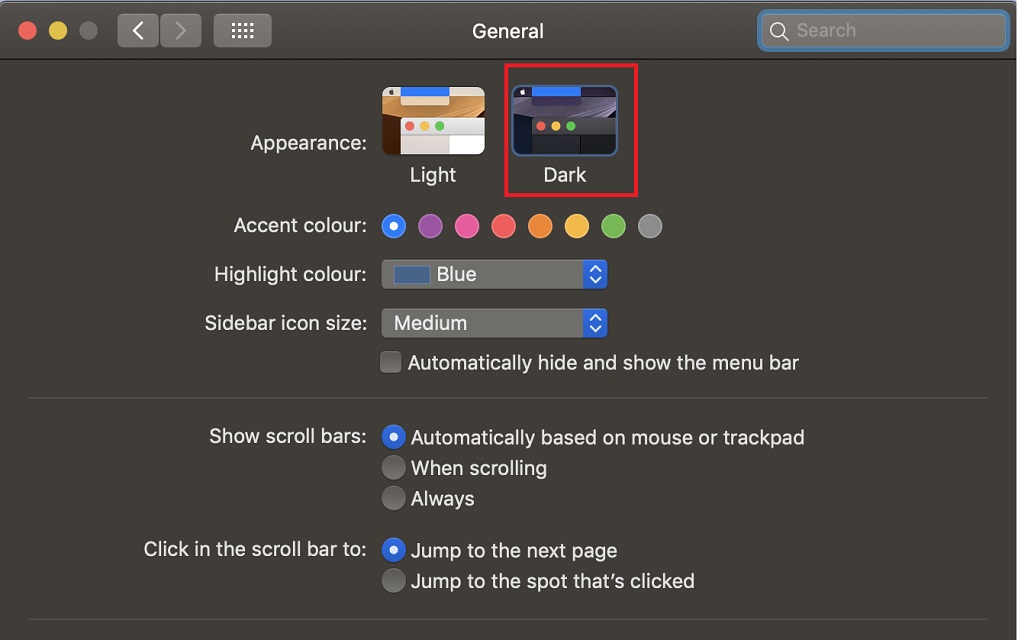
3. Enable Dark Mode on Android
It's surprising that Android doesn't have an official dark mode yet. This year, with the launch of Android Q beta, Google teased system-level dark mode, but it will be available to users worldwide next month. Even then, only a few phones will get the Android Q update at launch and many others will have to wait for months if not years to get it.
While various OEMs have brought some level of dark mode in the past, it doesn't force third-party apps to attune to the overall theme. However, things are changing with Android Q beta and you can now force apps to run in dark mode. I have shared a simple guide to force dark mode everywhere including third-party apps in the last section so check that out. Nevertheless, here is how you can enable system-level dark mode on Android Q with a few taps.
Open Settings and tap on Display. Here, enable the toggle for "Dark" theme. That's it. You can also enable dark mode by turning on the "Battery saver" mode from Quick Settings tiles.

4. Enable Dark Mode on iOS
iOS is also bringing system-wide dark mode this year with the release of iOS 13. It works across the system and apps developed by Apple. With time, third-party developers will be able to incorporate system-level dark mode in their app and then you will have a cohesive dark mode across the entire system, The stable version of iOS 13 will be released in September, however, if you are on the iOS 13 beta, you can enable dark mode right now.
To do that, open Settings and tap on "Display & Brightness". At the top, you will find "Light" and "Dark" mode. Choose the "Dark" mode option and you are done.
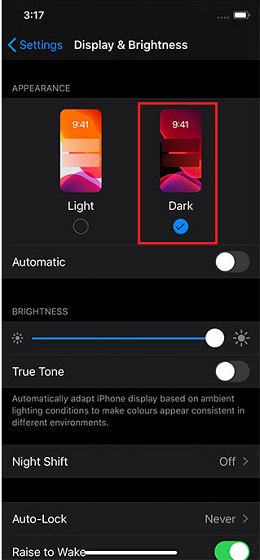
If you are on iOS 12, you can get dark mode by using an accessibility feature. Just open Settings and navigate to General -> Accessibility -> Display Accommodations -> Invert Colors. Here, enable the "Smart Invert" toggle. That's it. But keep in mind, it basically inverts the colors and may not look as cohesive and color accurate as you would expect.

How to Enable Dark Mode on Browsers
1. Enable Dark Mode on Google Chrome
Google brought official dark mode with the release of Chrome 74. While the dark mode is readily available on macOS, Windows and other platforms are going through slow rollout. Having said that, here I will show you how you can enable dark mode on Google Chrome for all the major platforms. But do note that it's not a complete dark mode. It will only change Settings, homepage and new tab to dark mode and not the content of web pages. If you want full dark mode for Chrome, you can head over to our full guide.
Windows
Dark mode is now officially available on Chrome for Windows platform. However, the rollout is slow and many users are yet to get it. So if you want to force enable dark mode on Chrome for Windows 10 then follow these steps.
Right-click on Chrome and open "Properties". Now, copy and paste the following command at the end of the target box. Now, click on the "Ok" button and you are set to enjoy Chrome in dark mode.
--force-dark-mode
macOS
As I mentioned above, you don't need to separately enable dark mode on Chrome for macOS. All you have to do is enable the dark mode from System Preferences and Chrome will adapt to dark mode accordingly. Enjoy the seamless experience!
Android
1. Open Chrome and go to Settings. Here, you will find "Themes" option. Open it and select "Dark". The UI will change to dark mode instantly.

2. If you want to force dark mode on webpages as well then type chrome://flags in the address bar and open it. On the flags page, search for "dark" and enable "Android web contents dark mode". Now, the webpages will also adhere to the dark theme.

Note: Make sure Chrome is up to date. It should be on Chrome 75 or above.
iOS
While the dark mode is officially not available on Chrome for iOS, you can use an accessibility feature to achieve almost the same result. Here is you how you can enable dark mode on Chrome for iOS devices. Open Settings and navigate to General -> Accessibility -> Display Accommodations -> Invert Colors. Here, enable the "Smart Invert" toggle. Now you can use Chrome in dark mode.
That said, it's just a matter of time before Google updates Chrome to adhere to iOS 13's dark mode guidelines. Once it does, enabling dark mode on iOS will automatically change Chrome to dark mode just as it does in macOS.
2. Safari
Safari is only available on macOS and iOS devices. If you want to enable dark mode on Safari and you are on iOS 13 beta, just enable the system-level dark mode and Safari will follow suit. But, if you are on the stable iOS 12, you will have to access dark mode through the Reader View. Here is how you can do it.
Open any website and click on the "Reader View" icon at the left corner of the address bar. Now, click on the "Edit" button on the right corner of the address bar and select the dark circle. That's it the webpage will load in dark mode. Enjoy!
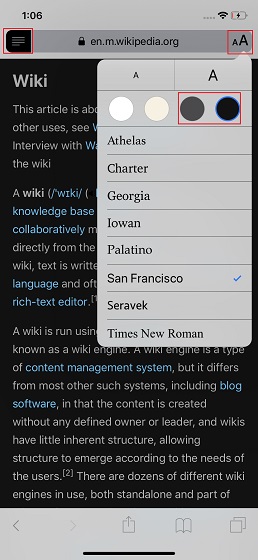
3. Firefox
Windows and macOS
If you have enabled dark mode from the system settings on Windows and macOS then Firefox should automatically switch to dark mode. In case it doesn't, you can change it manually.
Click on the hamburger menu and open "Add-ons". After that, switch to "Theme" on the left-side menu. Here, click on the "Enable" button beside the Dark theme and Firefox will completely change to dark mode. In case you want to darken the webpages too, install the Dark Reader add-on on Firefox.

Android and iOS
Firefox doesn't have a dark mode on both Android and iOS, but it does have support for add-ons. You can simply install the Dark Reader add-on and you can enjoy dark mode across the web.
4. Microsoft Edge
1. If you are using Microsoft Edge that comes pre-installed with Windows 10 then the process is pretty simple. Just open the 3-dot menu on the top-right corner and click on "Settings". Under the "General" tab, choose the "Dark" theme. That's it.
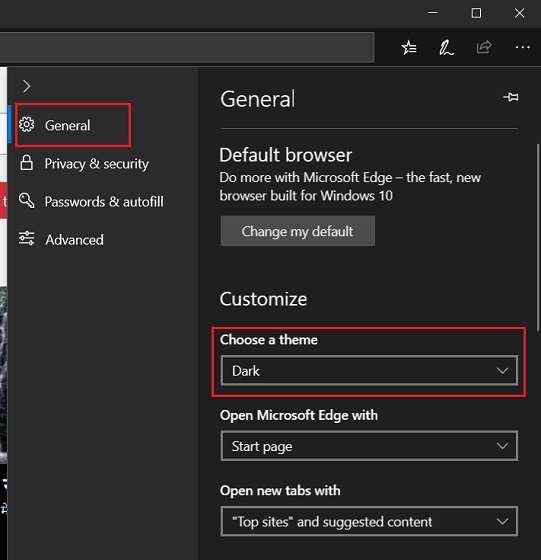
2. In case, you are using the Chromium build of Microsoft Edge, then it should automatically change to dark mode depending on the system theme. However, to manually activate dark mode, open Edge and type edge://flags in the URL bar and hit enter. After that, search for "theme" and you will find "Microsoft Edge Theme". Click on the drop-down menu and select "Enabled".
 3. Now, restart Edge and dark mode should be activated. If you want to darken the webpages too then install the Dark Reader extension from Chrome Web Store.
3. Now, restart Edge and dark mode should be activated. If you want to darken the webpages too then install the Dark Reader extension from Chrome Web Store.
Dark Mode on Social Media
1. Enable Dark Mode on Twitter
On the Web
Twitter has released a new web UI which frankly looks great. It is very similar to the mobile app and includes dark mode and bookmark features. If you have got the new Twitter UI then it's pretty easy to enable dark mode. Just click on "More" on the left menu and then open "Display". Here, either choose "Dim" for material black or "Lights Out" for pure black. That's it. Now your Twitter should be in dark mode. Also, if you want to experience the new web UI, you can get it from here.

In case you are on the old Twitter web UI, you can also enable dark mode on Twitter. Just click on your "Profile" icon and click on the "Dark" mode at the bottom. Voila, there you have it.
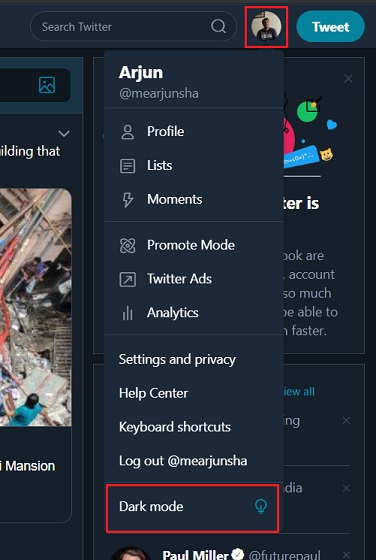
Android and iOS
On Android and iOS, the process is pretty straightforward. Open Twitter and swipe right to open the Twitter menu. Here, tap on the "bulb" icon at the bottom-left corner and you are good to go.
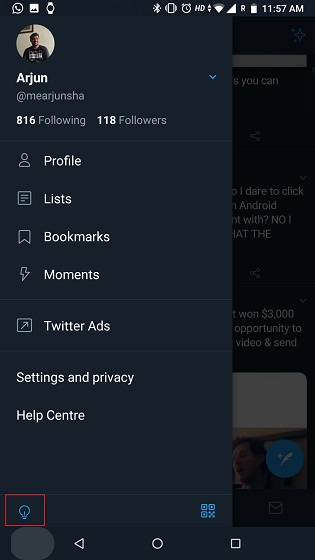
If you want contrasty blacks on iOS, open Twitter and swipe right. Navigate to Settings and Privacy -> Display and Sound. Select the "Lights Out" option and there you have it.

2. Enable Dark Mode on Facebook and Instagram
Facebook and Instagram, both don't have a dark mode yet either on mobile apps or website. However, you can get very close to dark mode on web browsers by using the Dark Reader extension. You can install it on your browser and you will be able to experience Facebook and Instagram in complete dark mode.

Besides that, if you are using an Android device with Android Q beta, you can force apps to run in dark mode. It essentially means that you will be able to run both Facebook and Instagram apps in dark mode on Android Q. I have mentioned the steps in the next section so check it out.
Force Dark Mode on Android Q
Android Q has something called force dark mode which basically overrides the default theme of apps with a dark theme. While the end result is not as clean as you would expect, it sure looks great and gives a glimpse on how apps will look after proper dark theme implementation. In this section, I will show you how to enable force dark mode on Android Q beta in simple steps. So without wasting any time, let's begin with the steps.
1. First of all, enable "Developer Options" by tapping on the build number 6 times. You will find "Build number" in Settings -> About Phone.
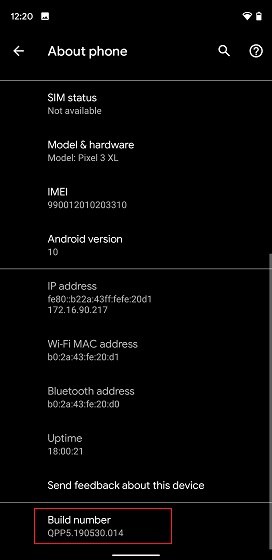
2. Open Settings and navigate to System -> Advanced -> Developer Options -> Scroll down to almost bottom and find "Override force-dark". If you are unable to find it, just search "override dark" and it should show up. Now, enable the toggle and you are done.

3. Open any app and it should be in dark mode including Google app, Facebook, Instagram and many more. Enjoy!

SEE ALSO: iOS 13 Dark Mode vs Android Q Dark Mode
Enable Dark Mode Everywhere and Go Easy on Your Eyes
So that was our complete guide on how to enable dark mode everywhere. I have included major operating systems for both mobile and desktop, web browsers, and popular social media websites. Let's be real, we spend too much time on all of our devices and it would be better if we embrace dark mode to protect our eyes from continuous strain. If we missed something in this article, do let us know in the comment section below. We will be happy to take a look.

Comments
Post a Comment